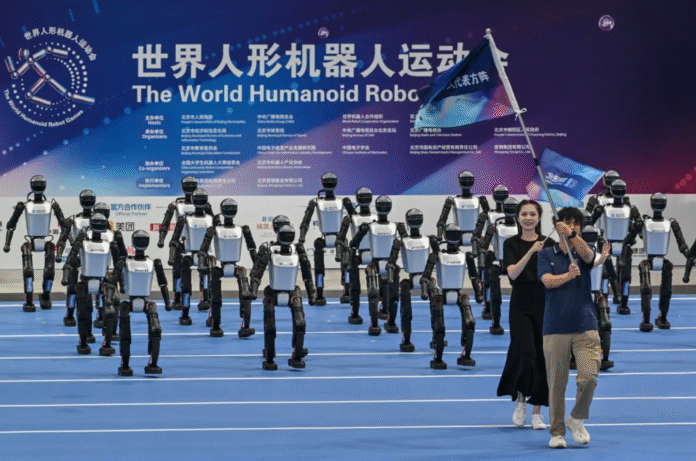China’s First-Ever Robot Olympics
The humanoid robot games China just made history with a groundbreaking event that combined futuristic innovation with Olympic-style competition. Hosted in Beijing, this first-of-its-kind tournament showcased more than 500 androids as they stumbled, sprinted, boxed, and even practiced kung fu. While some fell flat on their metallic faces, others delivered jaw-dropping performances that offered a glimpse into the future of artificial intelligence and robotics.
This remarkable event signals a turning point not just for robotics, but also for global technology competition, where China aims to prove its dominance.
A Historic First: Humanoid Robot Games China
The inaugural World Humanoid Robot Games saw participation from 28 0 robotics teams representing 16 countries. Held at the iconic National Speed Skating Oval in Beijing, a stadium originally built for the 2022 Winter Olympics, the event was designed to push androids to their limits in both athletic and practical challenges.
The competitions ranged from traditional sports such as basketball, athletics, and football, to highly practical tasks like medicine categorisation and cleaning assignments. This unique blend highlighted not only the entertainment side of robotics but also their growing role in industries like healthcare and household assistance.

Robots That Tumbled, Stumbled, and Amazed
Despite the futuristic setup, it quickly became clear that humanoid robots are still far from flawless. In the five-a-side football match, 10 robots each the size of a seven-year-old child, shuffled clumsily across the field, often getting stuck in scrums or falling over in groups.
Yet, not everything was clumsy. A highlight came during the 1,500m race, where Unitree’s humanoid robot thundered down the track at an unexpectedly fast pace, finishing in 6 minutes and 29.37 seconds. While that’s nowhere near the human record of 3:26.00, it was impressive enough to grab the crowd’s attention and show how quickly the technology is advancing.
One dramatic moment saw a robot collide head-on with a human operator. The machine stayed upright while the human was knocked flat fortunately, no injuries were reported.
China’s Global Robotics Ambition
The humanoid robot games China were not just about fun competitions. They are part of Beijing’s national strategy to dominate the robotics and artificial intelligence industry. According to the International Federation of Robotics, China has placed humanoids at the “center of their national development plan.”
Earlier this year, China unveiled a ¥1 trillion ($139 billion) fund dedicated to supporting startups in emerging technologies such as robotics and AI. This massive investment makes clear that the country doesn’t just want to participate in robotics innovation, it wants to lead it.
Already the world’s largest market for industrial robots, China is determined to extend that dominance into humanoids, with the long-term goal of creating machines that can work, think, and even compete like humans.
Humanoid Robot Games: A Glimpse Into the Future
Many spectators were left amazed, including 18-year-old Chen Ruiyuan, who confidently stated:
“I believe in the next 10 years or so, robots will be basically at the same level as humans.”
That prediction might sound ambitious, but it aligns with the progress on display. From robots boxing to those attempting the high jump, every event showed incremental advancements in balance, coordination, and intelligence.
These games may seem entertaining today, but in just a decade, they could pave the way for robotic workers in factories, caretakers in hospitals, and even android athletes competing alongside humans.
Why the Humanoid Robot Games Matter
The launch of the humanoid robot games China is more than just a flashy tech event. It reflects a deeper geopolitical rivalry. Just as space exploration in the 20th century symbolized global power, robotics is now the new frontier.
-
For China, this was a chance to showcase technological supremacy.
-
For the world, it was an opportunity to measure just how fast robotics is advancing.
-
For businesses and investors, it was a peek into the next trillion-dollar industry.
External experts suggest that within 15 years, humanoid robots could become as common as smartphones, transforming how we live and work.
Conclusion: The Rise of Humanoid Robot Games China
The debut of the humanoid robot games China has set a bold tone for the future. With 500 robots competing in hurdles, kung fu, and even boxing, Beijing demonstrated its technological might while also entertaining the world.
Although androids are still far from matching human speed, strength, and agility, their rapid progress is undeniable. What once looked like science fiction is now unfolding on the world stage and China wants to be at the center of it all.
The world is watching closely. Will humanoid robots one day rival human athletes, or even surpass them? The games in Beijing might just be the first chapter in a story that redefines the future of both sports and society.

